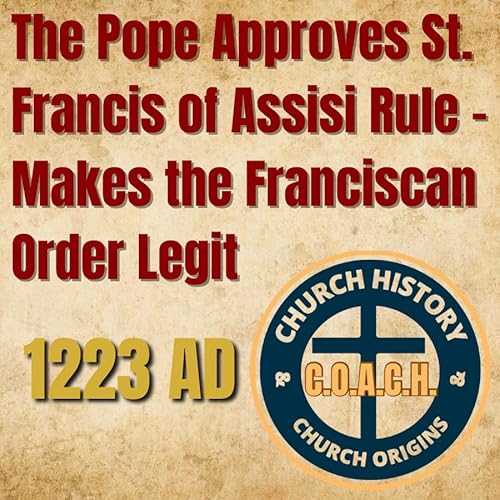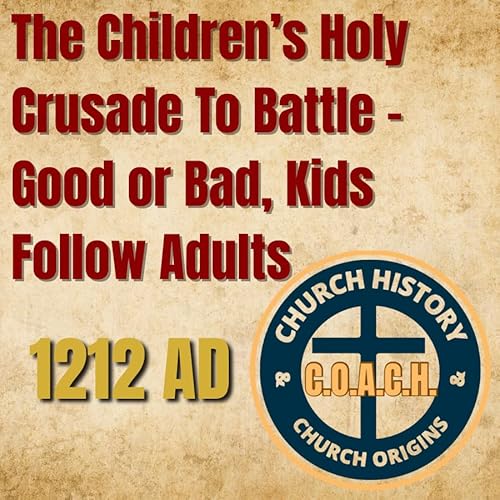460 AD – Writing Through Ruin: One Bishop Preserved Faith Amid Chaos, What Will History Say About the Story We Leave Behind? Metadata In 460 AD, Hydatius of Aquae Flaviae finished his Chronicle, a desperate record of raids, famine, heresy, and fading empire. From Gallaecia, he captured what others ignored: bishops resisting invaders, signs in the sky, faith clinging to hope. This episode explores how one man's pen preserved collapse and conviction — and asks how our own records will be judged by future generations. Make sure you Like, Share, Subscribe, Follow, Comment, and Review this episode and the entire COACH series. Keywords: Hydatius, Chronicle, Gallaecia, Aquae Flaviae, late antiquity, barbarian invasions, Suebi, Vandal, collapse, church history, chronicles, apocalypse, Arianism, Iberia, prophecy Hashtags: #ChurchHistory #Chronicles #LateAntiquity #Collapse #Faith Description: Step into 460 AD, where Hydatius of Aquae Flaviae completes his Chronicle — a rare eyewitness record from the crumbling edges of the Roman world. In Gallaecia, modern-day Galicia, bishops faced Suebi raids, famine tore at communities, heresies spread, and celestial signs seemed to promise the end. Hydatius, once kidnapped himself, kept writing: not to glorify Rome but to warn his people that sin corrodes faster than swords. His Chronicle became the lone surviving Latin history of Iberia's collapse, later copied by monks for centuries. This episode brings his story into focus — how one bishop preserved faith through ruin, and why his warnings still challenge us. Today, everything is recorded, yet so often it is the trivial that fills our archives. Will generations after us see people consumed with distractions, or disciples who left a witness of faith? Like, share, and subscribe to COACH for more stories of church origins and history that still speak today. Chunk 1 – Cold Hook The year is 460. In an ancient city about an hour and a half's drive northeast of modern Porto, Portugal — and roughly 250 miles northwest of Madrid, Spain — famine and fear press on every side. Raiding tribes strip villages bare, heresies spread inside the churches, and the sky itself seems filled with warnings. In the middle of this, a bishop named Hydatius [hy-DAY-shus] takes up his pen. He writes down what others would rather forget: violence, hunger, corruption, and signs of judgment. His chronicle is less about emperors and more about survival — the faith of ordinary Christians under siege. To him, sin rots faster than swords, and memory is the only defense left. But if the world truly seemed to be ending, why did Hydatius keep writing? [AD BREAK] Chunk 2 – Show Intro From the That's Jesus Channel, welcome to COACH — where Church origins and church history actually coach us how to walk boldly with Jesus today. I'm Bob Baulch. On Monday, we stay between 0 and 500 AD. In this episode we are in the year 460 AD, as Bishop Hydatius finishes his running diary of disaster and faith — preserving the collapse of Roman Spain, and raising questions about how we record our own lives for the generations to come. Chunk 3 – Foundation Hydatius [hy-DAY-shus] was born around the year 400 in the rugged hills of northern Portugal. As a boy he traveled to the Holy Land with his mother and met Jerome — the scholar who translated the entire Bible into Latin, a version that shaped Christian life for centuries. At that time, Jerome had recently finished a running diary of world events written year by year. That kind of record is called a chronicle. Years later, Hydatius became bishop of a frontier city battered by hunger, raiders, and heresy. In 460, he finished his own chronicle, picking up where Jerome had stopped in 378 and carrying the story into his own lifetime. This was no polished history from Rome's palaces. Hydatius wrote from the edge of collapse, recording the dangers pressing on his region and the moral decay he believed fueled them. He set out not to glorify Rome but to warn the Church, convinced that history itself was rushing toward an end. Chunk 4 – Development Hydatius wrote with urgency because his world kept unraveling. Raids emptied villages, famine forced families to scatter, and false teaching spread like infection. He warned that these disasters were not random. To him, they were signs that sin had weakened the foundations of society, and that judgment was at the door. His chronicle lists celestial warnings — eclipses, comets, even falling stars — as if heaven itself were echoing the chaos on earth. Hydatius lived as if the end of the world was imminent, pointing to every disaster as proof. For him, the evidence was overwhelming, though history shows that suffering itself does not always signal the finish line. He was not the only Christian writer wrestling with disaster. A generation earlier, Augustine of Hippo [AW-gus-teen] had written The City of God in the 420s. Augustine argued that Rome's fall was not the ...
Show More
Show Less
 15 mins
15 mins Oct 6 202517 mins
Oct 6 202517 mins 21 mins
21 mins Oct 5 202510 mins
Oct 5 202510 mins 18 mins
18 mins Oct 1 202510 mins
Oct 1 202510 mins 11 mins
11 mins 12 mins
12 mins

